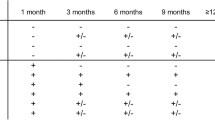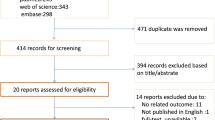Abstract
Microscopic microvascular decompression (M-MVD) is a classical treatment for relieving long-term hemifacial spasms (HFS). An endoscopy technique has recently been introduced to improve M-MVD; however, this application remains debatable. This study compared the safety and effectiveness of endoscope-assisted microvascular decompression (EA-MVD) and M-MVD for HFS. From February 2021 to September 2022, we enrolled 49 patients with HFS assigned to the EA-MVD (n = 26) and M-MVD (n = 23) groups. The patients were assessed with Park YS grades, operative time, hospital days, and complications. Evaluations were performed in the early postoperative period, at one month, 3 months, 6 months, and at least 12 months. Twenty-three (23/26, 88.5%) patients in the EA-MVD group and 20 (20/23, 87.0%) patients in the M-MVD group achieved spasm-free relief, ranging over “excellent” and “good” Park YS grades. The operative time in the EA-MVD and M-MVD groups were 143 ± 28 min and 145 ± 22 min (p = 0.002). The duration of hospital stay was 6.8 ± 0.8 days and 7.2 ± 1.3 days in the EA-MVD and M-MVD groups (p = 0.002), respectively. All surgeries for HFS were successful, with no death, stroke, hearing loss, facial numbness, or other extreme complications. In conclusion, EA-MVD, compared with M-MVD, demonstrated equally effective outcomes with decreased operative time and hospital stays, providing bright intraoperative illumination and flexible surgical vision.


Similar content being viewed by others
Data availability
The data were not available.
References
Krishnan AV, Hayes M, Kiernan MC (2007) Axonal excitability properties in hemifacial spasm. Mov Disord 22:1293–1298. https://doi.org/10.1002/mds.21512
Loeser JD, Chen J (1983) Hemifacial spasm: treatment by microsurgical facial nerve decompression. Neurosurgery 13:141–146. https://doi.org/10.1097/00006123-198308000-00006
Jannetta PJ, Abbasy M, Maroon JC, Ramos FM, Albin MS (1977) Etiology and definitive microsurgical treatment of hemifacial spasm. Operative techniques and results in 47 patients. J Neurosurg 47:321–328. https://doi.org/10.3171/jns.1977.47.3.0321
Han IB, Chang JH, Chang JW, Huh R, Chung SS (2009) Unusual causes and presentations of hemifacial spasm. Neurosurgery 65:130–137. https://doi.org/10.1227/01.NEU.0000348548.62440.42
Markey JD, Loyo M (2017) Latest advances in the management of facial synkinesis. Curr Opin Otolaryngol Head Neck Surg 25:265–272. https://doi.org/10.1097/MOO.0000000000000376
Park YS, Chang JH, Cho J, Park YG, Chung SS, Chang JW (2006) Reoperation for persistent or recurrent hemifacial spasm after microvascular decompression. Neurosurgery 58:1162–1167. https://doi.org/10.1227/01.NEU.0000215954.97948.B3
Shin JC, Chung UH, Kim YC, Park CI (1997) Prospective study of microvascular decompression in hemifacial spasm. Neurosurgery 40:730–734. https://doi.org/10.1097/00006123-199704000-00013
Sekula RF Jr, Frederickson AM, Arnone GD, Quigley MR, Hallett M (2013) Microvascular decompression for hemifacial spasm in patients >65 years of age: an analysis of outcomes and complications. Muscle Nerve 48:770–776. https://doi.org/10.1002/mus.23800
Chaudhry N, Srivastava A, Joshi L (2015) Hemifacial spasm: the past, present and future. J Neurol Sci 356:27–31. https://doi.org/10.1016/j.jns.2015.06.032
Auger RG, Whisnant JP (1990) Hemifacial spasm in Rochester and Olmsted County, Minnesota, 1960–1984. Arch Neurol 47:1233–1234. https://doi.org/10.1001/archneur.1990.00530110095023
Lawrence JD, Frederickson AM, Chang YF, Weiss PM, Gerszten PC, Sekula RF (2018) An investigation into quality of life improvement in patients undergoing microvascular decompression for hemifacial spasm. J Neurosurg 128:193–201. https://doi.org/10.3171/2016.9.JNS161022
Wu Y, Davidson AL, Pan T, Jankovic J (2010) Asian over-representation among patients with hemifacial spasm compared to patients with cranial-cervical dystonia. J Neurol Sci 298:61–63. https://doi.org/10.1016/j.jns.2010.08.017
Møller AR (1999) Vascular compression of cranial nerves: II: pathophysiology. Neurol Res 21:439–443. https://doi.org/10.1080/01616412.1999.11740957
Nielsen VK (1984) Pathophysiology of hemifacial spasm: I Ephaptic transmission and ectopic excitation. Neurology 34:418–426. https://doi.org/10.1212/WNL.34.4.418
Joo BE, Kim JS, Deletis V, Park KS (2022) Advances in intraoperative neurophysiology during microvascular decompression surgery for hemifacial spasm. J Clin Neurol 18:410–420. https://doi.org/10.3988/jcn.2022.18.4.410
Montava M, Rossi V, CurtoFais CL, Mancini J, Lavieille JP (2016) Long-term surgical results in microvascular decompression for hemifacial spasm: efficacy, morbidity and quality of life. Acta Otorhinolaryngol Ital 36:220–227. https://doi.org/10.14639/0392-100X-899
Gardner WJ, Miklos MV (1959) Response of trigeminal neuralgia to decompression of sensory root; discussion of cause of trigeminal neuralgia. J Am Med Assoc 170:1773–1776. https://doi.org/10.1001/jama.1959.03010150017004
Jho HD, Jannetta PJ (1987) Hemifacial spasm in young people treated with microvascular decompression of the facial nerve. Neurosurgery 20:767–770. https://doi.org/10.1097/00006123-198705000-00015
Kaufmann AM, Price AV (2019) A history of the Jannetta procedure. J Neurosurg 132:639–646. https://doi.org/10.3171/2018.10.JNS181983
Barker FG 2nd, Jannetta PJ, Bissonette DJ, Shields PT, Larkins MV, Jho HD (1995) Microvascular decompression for hemifacial spasm. J Neurosurg 82:201–210. https://doi.org/10.3171/jns.1995.82.2.0201
Møller AR, Jannetta PJ (1985) Hemifacial spasm: results of electrophysiologic recording during microvascular decompression operations. Neurology 35:969–974. https://doi.org/10.1212/WNL.35.7.969
Mattick RP, Clarke JC (1998) Development and validation of measures of social phobia scrutiny fear and social interaction anxiety. Behav Res Ther 36:455–470. https://doi.org/10.1016/S0005-7967(97)10031-6
Park JS, Kong DS, Lee JA, Park K (2008) Hemifacial spasm: neurovascular compressive patterns and surgical significance. Acta Neurochir (Wien) 150:235–241. https://doi.org/10.1007/s00701-007-1457-x
Campos-Benitez M, Kaufmann AM (2008) Neurovascular compression findings in hemifacial spasm. J Neurosurg 109:416–420. https://doi.org/10.3171/JNS/2008/109/9/0416
Bigder MG, Kaufmann KAM (2016) Failed microvascular decompression surgery for hemifacial spasm due to persistent neurovascular compression: an analysis of reoperations. J Neurosurg 124:90–95. https://doi.org/10.3171/2015.1.JNS142714
Feng BH, Zhong WX, Li ST, Wang XH (2020) Fully endoscopic microvascular decompression of the hemifacial spasm: our experience. Acta Neurochir (Wien) 162:1081–1087. https://doi.org/10.1007/s00701-020-04245-5
Shu W, Zhu H, Li Y, Liu R (2019) Clinical analysis of repeat microvascular decompression for recurrent hemifacial spasm. Acta Neurol Belg 119:453–459. https://doi.org/10.1007/s13760-019-01103-9
Kondo A (1997) Follow-up results of microvascular decompression in trigeminal neuralgia and hemifacial spasm. Neurosurgery 40:46–51. https://doi.org/10.1227/00006123-199701000-00009
Guo X, Zhang C, Li Y, Li X, Ma X, Li W (2022) Fully endoscopic microvascular decompression for hemifacial spasm using improved retrosigmoid infrafloccular approach: clinical analysis of 81 cases. Oper Neurosurg (Hagerstown) 23:40–45. https://doi.org/10.1227/ons.0000000000000221
Acknowledgements
The authors thank Hao Yan, MD, for his support of the statistical aspect of this study.
Funding
This research was supported by the Bei**g Nature & Science Foundation of China (grant number Z210009), Research Fund of Science and Technology Innovation 2030—Major Project (grant number 2021ZD0201600), and Bei**g Municipal Administration of Hospitals Incubating Program (PX2022034), the National Natural Science Foundation of China (U20A20391) and Supported by the National Key Research and Development Program of China (No. 2022YFC3602203).
Author information
Authors and Affiliations
Contributions
All the authors had collectively dedicated significant efforts to this study. Wei Shu and Dou Yang formulated the study design. The surgical procedure was performed by Wei Shu, Junchi Li, Tao Du, and Hongwei Zhu. Dou Yang and Hao Yan conducted the statistical analysis. Dou Yang prepared the manuscript and collaborated with Wei Shu to edit it. Hongwei Zhu carried out a thorough review of the manuscript. Wei Shu and Dou Yang guaranteed the integrity of the entire study.
Corresponding author
Ethics declarations
Conflict of interest
The authors declare that the research was conducted without any commercial or financial relationships that could be construed as a potential conflict of interest.
Ethical approval
The study was conducted according to the principles of the Declaration of Helsinki, and the local ethics committee approved it. The patients or their legal representatives provided written informed consent to participate in this study and surgery.
Additional information
Publisher's Note
Springer Nature remains neutral with regard to jurisdictional claims in published maps and institutional affiliations.
Rights and permissions
Springer Nature or its licensor (e.g. a society or other partner) holds exclusive rights to this article under a publishing agreement with the author(s) or other rightsholder(s); author self-archiving of the accepted manuscript version of this article is solely governed by the terms of such publishing agreement and applicable law.
About this article
Cite this article
Yang, D., Shu, W., Du, T. et al. Safety and efficacy of endoscope-assisted versus microscopic microvascular decompression surgery for hemifacial spasm: a prospective cohort study. Acta Neurol Belg (2024). https://doi.org/10.1007/s13760-024-02539-4
Received:
Accepted:
Published:
DOI: https://doi.org/10.1007/s13760-024-02539-4




